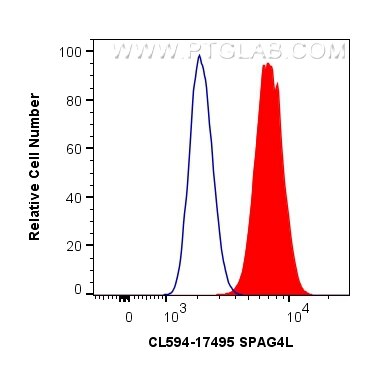Tested Applications
| Positive FC (Intra) detected in | PC-3 cells |
| Positive FC detected in | PC-3 cells |
Recommended dilution
| Application | Dilution |
|---|---|
| Flow Cytometry (FC) (INTRA) | FC (INTRA) : 0.80 ug per 10^6 cells in a 100 µl suspension |
| Flow Cytometry (FC) | FC : 0.80 ug per 10^6 cells in a 100 µl suspension |
| It is recommended that this reagent should be titrated in each testing system to obtain optimal results. | |
| Sample-dependent, Check data in validation data gallery. | |
Product Information
CL594-17495 targets SPAG4L in FC (Intra) applications and shows reactivity with human, mouse samples.
| Tested Reactivity | human, mouse |
| Host / Isotype | Rabbit / IgG |
| Class | Polyclonal |
| Type | Antibody |
| Immunogen |
CatNo: Ag11629 Product name: Recombinant human SPAG4L protein Source: e coli.-derived, PET28a Tag: 6*His Domain: 1-379 aa of BC026118 Sequence: MPRSSRSPGDPGALLEDVAHNPRPRRIAQRGRNTSRMAEDTSPNMNDNILLPVRNNDQALGLTQCMLGCVSWFTCFACSLRTQAQQVLFNTCRCKLLCQKLMEKTGILLLCAFGFWMFSIHLPSKMKVWQDDSINGPLQSLRLYQEKVRHHSGEIQDLRGSMNQLIAKLQEMEAMSDEQKMAQKIMKMIHGDYIEKPDFALKSIGASIDFEHTSVTYNHEKAHSYWNWIQLWNYAQPPDVILEPNVTPGNCWAFEGDRGQVTIQLAQKVYLSNLTLQHIPKTISLSGSLDTAPKDFVIYGMEGSPKEEVFLGAFQFQPENIIQMFPLQNQPARAFSAVKVKISSNWGNPGFTCLYRVRVHGSVAPPREQPHQNPYPKRD Predict reactive species |
| Full Name | sperm associated antigen 4-like |
| Calculated Molecular Weight | 379 aa, 43 kDa |
| Observed Molecular Weight | 43 kDa |
| GenBank Accession Number | BC026118 |
| Gene Symbol | SPAG4L |
| Gene ID (NCBI) | 140732 |
| RRID | AB_2919843 |
| Conjugate | CoraLite®594 Fluorescent Dye |
| Excitation/Emission Maxima Wavelengths | 588 nm / 604 nm |
| Form | Liquid |
| Purification Method | Antigen affinity purification |
| UNIPROT ID | Q8TC36 |
| Storage Buffer | PBS with 50% glycerol, 0.05% Proclin300, 0.5% BSA, pH 7.3. |
| Storage Conditions | Store at -20°C. Avoid exposure to light. Stable for one year after shipment. Aliquoting is unnecessary for -20oC storage. |
Background Information
SPAG4L,also named as SUN domain-containing protein 5 or Testis and spermatogenesis-related gene 4 protein, is a 379 amino acid protein, which contains 1 SUN domain. SPAG4L is widely expressed and localizes in the nucleus inner membrane. SPAG4L is restricted to the apical nuclear region of round spermatids that face the acrosomic vesicle. SPAG4L is involved in linkage of the acrosomic vesicle to the spermatid nucleus, and in acrosome biogenesis.
Protocols
| Product Specific Protocols | |
|---|---|
| FC protocol for CL594 SPAG4L antibody CL594-17495 | Download protocol |
| Standard Protocols | |
|---|---|
| Click here to view our Standard Protocols |




